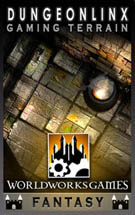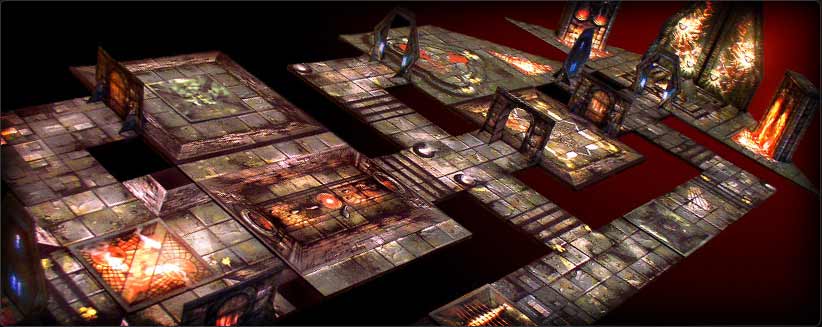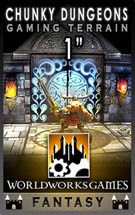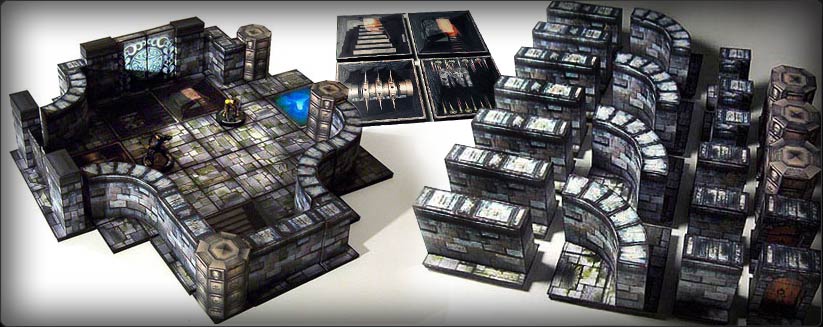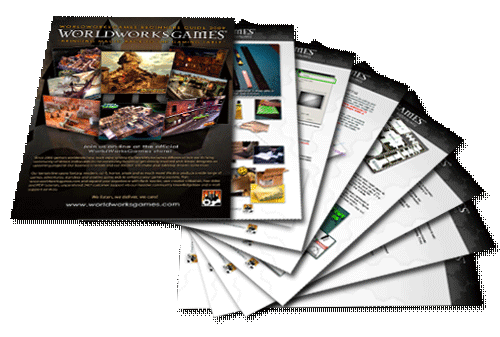Siran Dunmorgan
First Post
I have pretty much the entire Fat Dragon "Dragon Tiles" line, and a fair number of E-Z Dungeons and E-Z Terrain lines. I've also got some of the Vyllage-on-the-Cheep sets, the WorldWorks Arena, and the Papermodel Civilizations desert sets.
So far, probably not too different from what the rest of you have done or are planning to do.
However, there are some additional tricks. For example, one of my kids had an art project for school where she was supposed to make a ceremonial gateway, similar to the Ishtar Gate of Babylon.
Rather than starting from a shoebox, as recommended in her school assignment, we used the gate, towers, and wall models from the WorldWorks ArenaWorks set.
We printed them to 'flat' PDF with PDFCreator—Inkscape won't read the embedded images directly in the WorldWorks PDFs—then modified the designs and textures in Inkscape, adding vines, leaves and cracks to create an 'older' look, and adding bas-relief animal designs and inscriptions along the walls.
After the edits, we printed the models, built them, and had a completely customized ceremonial gate that was something of the belle of the ball among the modified shoe- and cereal boxes that were turned in by the rest of her class.
I've used this technique—editing in Inkscape—to modify several tiles, e.g. putting a tan-colored wash over a set when it's supposed to be a sandy floor rather than rock, or adding images for light sources, magical effects, and whatnot. I have a swamp built from Fat Dragon's E-Z Terrain Forest & Ruins set, for example, adding more water features, darkening the overall texture, and adding a few hanging vines from strips of paper.
Cardstock models have really helped to encourage my kids to participate in building out the environments and then play in them. I strongly encourage this aspect of the hobby.
—Siran Dunmorgan
Links:
PDFCreator – Free program to allow any program (including Acrobat Reader) to print to PDF.
Inkscape – Free vector graphics program that can import and edit single pages of PDF files.
So far, probably not too different from what the rest of you have done or are planning to do.
However, there are some additional tricks. For example, one of my kids had an art project for school where she was supposed to make a ceremonial gateway, similar to the Ishtar Gate of Babylon.
Rather than starting from a shoebox, as recommended in her school assignment, we used the gate, towers, and wall models from the WorldWorks ArenaWorks set.
We printed them to 'flat' PDF with PDFCreator—Inkscape won't read the embedded images directly in the WorldWorks PDFs—then modified the designs and textures in Inkscape, adding vines, leaves and cracks to create an 'older' look, and adding bas-relief animal designs and inscriptions along the walls.
After the edits, we printed the models, built them, and had a completely customized ceremonial gate that was something of the belle of the ball among the modified shoe- and cereal boxes that were turned in by the rest of her class.
I've used this technique—editing in Inkscape—to modify several tiles, e.g. putting a tan-colored wash over a set when it's supposed to be a sandy floor rather than rock, or adding images for light sources, magical effects, and whatnot. I have a swamp built from Fat Dragon's E-Z Terrain Forest & Ruins set, for example, adding more water features, darkening the overall texture, and adding a few hanging vines from strips of paper.
Cardstock models have really helped to encourage my kids to participate in building out the environments and then play in them. I strongly encourage this aspect of the hobby.
—Siran Dunmorgan
Links:
PDFCreator – Free program to allow any program (including Acrobat Reader) to print to PDF.
Inkscape – Free vector graphics program that can import and edit single pages of PDF files.

